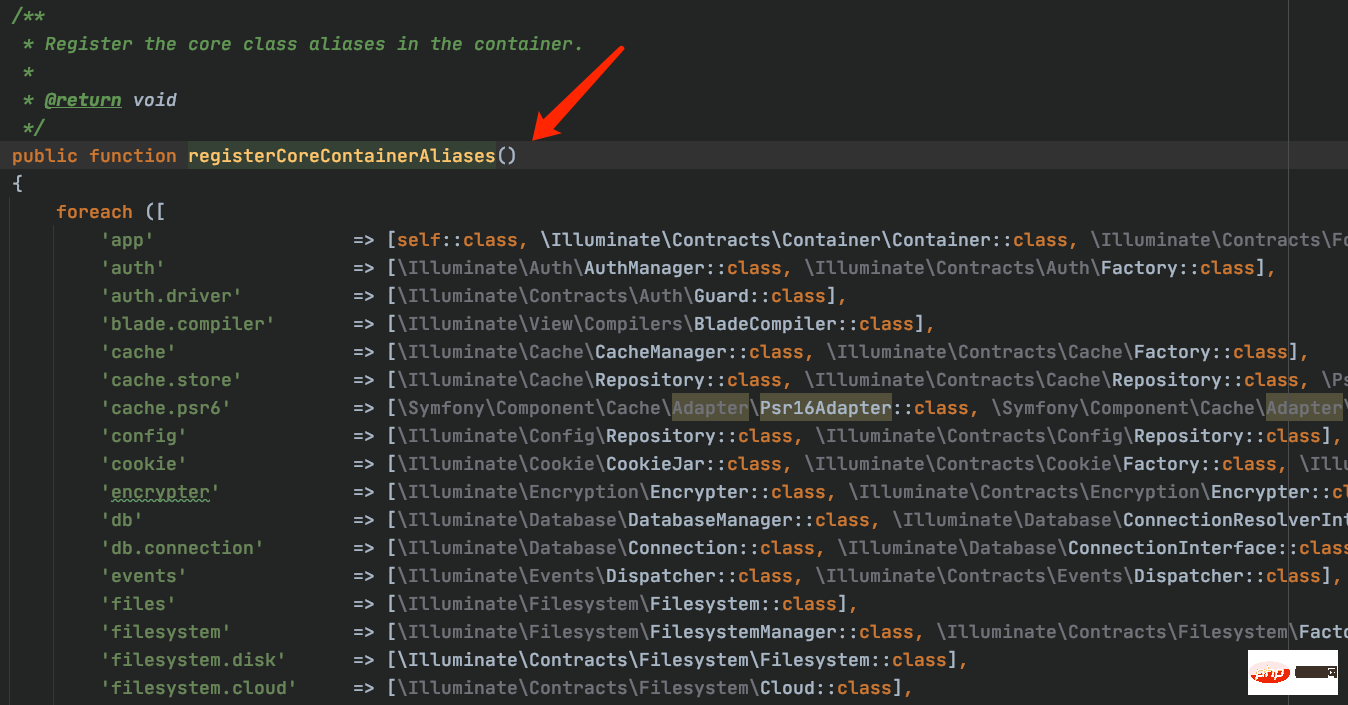一篇文章帶你徹底搞懂Laravel運作原理!
Laravel框架##aravel運作原則,希望教學為需要的朋友有所幫助!
前言
知其然知其所以然,剛開始接觸框架的時候大不部分人肯定一臉懵逼,不知道如何實現的,沒有一定的基礎知識,直接去看框架的源碼,只會被直接勸退,Laravel 框架是一款非常優秀的PHP 框架,這篇文章就是帶你徹底搞懂框架的運作原理,好讓你在面試的過程中有些談資(吹牛),學習和研究優秀框架的源碼也有助於我們自身技術的提升,接下來係好安全帶,老司機要開始開車了! ! !
準備知識
- 熟悉php 基本知識,如常見的陣列方法,閉包函數的使用,魔術方法的使用
- 熟悉php 的反射機制和依賴注入
- 熟悉php 命名空間概念和compose 自動載入
- 熟悉常見的設計模式,包括但不限於單例模式,工廠模式,門面模式,註冊樹模式,裝飾者模式等
運行原理概述
#Laravel 框架的入口檔案index.php
1、引入自動載入autoload.php 檔案
2、建立應用程式實例,並同時完成了
基本绑定($this、容器类Container等等)、 基本服务提供者的注册(Event、log、routing)、 核心类别名的注册(比如db、auth、config、router等)
3、開始Http 請求的處理
make 方法从容器中解析指定的值为实际的类,比如 $app->make(Illuminate\Contracts\Http\Kernel::class); 解析出来 App\Http\Kernel handle 方法对 http 请求进行处理 实际上是 handle 中 sendRequestThroughRouter 处理 http 的请求 首先,将 request 绑定到共享实例 然后执行 bootstarp 方法,运行给定的引导类数组 $bootstrappers,这里是重点,包括了加载配置文件、环境变量、服务提供者、门面、异常处理、引导提供者等 之后,进入管道模式,经过中间件的处理过滤后,再进行用户请求的分发 在请求分发时,首先,查找与给定请求匹配的路由,然后执行 runRoute 方法,实际处理请求的时候 runRoute 中的 runRouteWithinStack 最后,经过 runRouteWithinStack 中的 run 方法,将请求分配到实际的控制器中,执行闭包或者方法,并得到响应结果
4、 將處理結果回傳
詳細源碼分析
1、註冊自動載入類,實現檔案的自動載入
require __DIR__.'/../vendor/autoload.php';
2、建立應用程式容器實例Application (該實例繼承自容器類別Container),並綁定核心(web、命令列、異常),方便在需要的時候解析它們
$app = require_once __DIR__.'/../bootstrap/app.php';
app.php 檔案如下:
<?php // 创建Laravel实例 【3】 $app = new Illuminate\Foundation\Application( $_ENV['APP_BASE_PATH'] ?? dirname(__DIR__) ); // 绑定Web端kernel $app->singleton( Illuminate\Contracts\Http\Kernel::class, App\Http\Kernel::class); // 绑定命令行kernel $app->singleton( Illuminate\Contracts\Console\Kernel::class, App\Console\Kernel::class); // 绑定异常处理 $app->singleton( Illuminate\Contracts\Debug\ExceptionHandler::class, App\Exceptions\Handler::class); // 返回应用实例 return $app;
3、在建立應用程式實例(Application.php)的建構函式中,將基本綁定註冊到容器中,並註冊了所有的基本服務提供者,以及在容器中註冊核心類別名稱
#3.1、將基本綁定註冊到容器中
/**
* Register the basic bindings into the container.
*
* @return void
*/
protected function registerBaseBindings()
{
static::setInstance($this);
$this->instance('app', $this);
$this->instance(Container::class, $this);
$this->singleton(Mix::class);
$this->instance(PackageManifest::class, new PackageManifest(
new Filesystem, $this->basePath(), $this->getCachedPackagesPath()
));
# 注:instance方法为将...注册为共享实例,singleton方法为将...注册为共享绑定
}3.2、註冊所有基本服務提供者(事件,日誌,路由)
protected function registerBaseServiceProviders()
{
$this->register(new EventServiceProvider($this));
$this->register(new LogServiceProvider($this));
$this->register(new RoutingServiceProvider($this));
}3.3、在容器中註冊核心類別名稱

4、上面完成了類別的自動載入、服務提供者註冊、核心類別的綁定、以及基本註冊的綁定
5、開始解析http 的請求
index.php //5.1 $kernel = $app->make(Illuminate\Contracts\Http\Kernel::class); //5.2 $response = $kernel->handle( $request = Illuminate\Http\Request::capture());
5.1、make方法是從容器解析給定值
$kernel = $app->make(Illuminate\Contracts\Http\Kernel::class); 中的Illuminate\Contracts\Http\Kernel::class 是在index.php 中的$app = require_once __DIR__.'/../bootstrap/app.php';这里面进行绑定的,实际指向的就是App\Http\Kernel::class这个类
5.2、這裡對http 請求進行處理
$response = $kernel->handle( $request = Illuminate\Http\Request::capture());
進入$kernel 所代表的類別App\Http\Kernel.php 中,我們可以看到其實裡面只是定義了一些中間件相關的內容,並沒有handle 方法
我們再到它的父類別use Illuminate\Foundation\Http\Kernel as HttpKernel; 中找handle 方法,可以看到handle 方法是這樣的
public function handle($request){
try {
$request->enableHttpMethodParameterOverride();
// 最核心的处理http请求的地方【6】
$response = $this->sendRequestThroughRouter($request);
} catch (Exception $e) {
$this->reportException($e);
$response = $this->renderException($request, $e);
} catch (Throwable $e) {
$this->reportException($e = new FatalThrowableError($e));
$response = $this->renderException($request, $e);
}
$this->app['events']->dispatch(
new Events\RequestHandled($request, $response)
);
return $response;}6、處理Http 請求(將request 綁定到共用實例,並使用管道模式處理使用者請求)
vendor/laravel/framework/src/Illuminate/Foundation/Http/Kernel.php的handle方法// 最核心的处理http请求的地方$response = $this->sendRequestThroughRouter($request);protected function sendRequestThroughRouter($request){
// 将请求$request绑定到共享实例
$this->app->instance('request', $request);
// 将请求request从已解析的门面实例中清除(因为已经绑定到共享实例中了,没必要再浪费资源了)
Facade::clearResolvedInstance('request');
// 引导应用程序进行HTTP请求
$this->bootstrap();【7、8】 // 进入管道模式,经过中间件,然后处理用户的请求【9、10】
return (new Pipeline($this->app))
->send($request)
->through($this->app->shouldSkipMiddleware() ? [] : $this->middleware)
->then($this->dispatchToRouter());}7、在bootstrap 方法中,執行給定的引導類別數組$bootstrappers,載入設定檔、環境變數、服務提供者、門面、例外處理、引導提供者,非常重要的一步,位置在vendor/laravel/framework/src/Illuminate/Foundation/ Http/Kernel.php
/**
* Bootstrap the application for HTTP requests.
*
* @return void
*/public function bootstrap(){
if (! $this->app->hasBeenBootstrapped()) {
$this->app->bootstrapWith($this->bootstrappers());
}}/**
* 运行给定的引导类数组
*
* @param string[] $bootstrappers
* @return void
*/public function bootstrapWith(array $bootstrappers){
$this->hasBeenBootstrapped = true;
foreach ($bootstrappers as $bootstrapper) {
$this['events']->dispatch('bootstrapping: '.$bootstrapper, [$this]);
$this->make($bootstrapper)->bootstrap($this);
$this['events']->dispatch('bootstrapped: '.$bootstrapper, [$this]);
}}/**
* Get the bootstrap classes for the application.
*
* @return array
*/protected function bootstrappers(){
return $this->bootstrappers;}/**
* 应用程序的引导类
*
* @var array
*/protected $bootstrappers = [
// 加载环境变量
\Illuminate\Foundation\Bootstrap\LoadEnvironmentVariables::class,
// 加载config配置文件【重点】
\Illuminate\Foundation\Bootstrap\LoadConfiguration::class,
// 加载异常处理
\Illuminate\Foundation\Bootstrap\HandleExceptions::class,
// 加载门面注册
\Illuminate\Foundation\Bootstrap\RegisterFacades::class,
// 加载在config/app.php中的providers数组里所定义的服务【8 重点】
\Illuminate\Foundation\Bootstrap\RegisterProviders::class,
// 记载引导提供者
\Illuminate\Foundation\Bootstrap\BootProviders::class,];8、載入config/app.php 中的providers 陣列裡定義的服務
Illuminate\Auth\AuthServiceProvider::class,Illuminate\Broadcasting\BroadcastServiceProvider::class,....../** * 自己添加的服务提供者 */\App\Providers\HelperServiceProvider::class,
可以看到,關於常用的Redis、session、queue、auth、database、Route 等服務都是在這裡進行載入的
9、使用管道模式處理使用者請求,先經過中間件進行處理和過濾
return (new Pipeline($this->app))
->send($request)
// 如果没有为程序禁用中间件,则加载中间件(位置在app/Http/Kernel.php的$middleware属性)
->through($this->app->shouldSkipMiddleware() ? [] : $this->middleware)
->then($this->dispatchToRouter());}app/Http/Kernel.php
/**
* 应用程序的全局HTTP中间件
*
* These middleware are run during every request to your application.
*
* @var array
*/protected $middleware = [
\App\Http\Middleware\TrustProxies::class,
\App\Http\Middleware\CheckForMaintenanceMode::class,
\Illuminate\Foundation\Http\Middleware\ValidatePostSize::class,
\App\Http\Middleware\TrimStrings::class,
\Illuminate\Foundation\Http\Middleware\ConvertEmptyStringsToNull::class,];10、經過中間件處理後,再進行請求分發(包括查找匹配路由)
/**
* 10.1 通过中间件/路由器发送给定的请求
*
* @param \Illuminate\Http\Request $request
* @return \Illuminate\Http\Response
*/
protected function sendRequestThroughRouter($request){
...
return (new Pipeline($this->app))
...
// 进行请求分发
->then($this->dispatchToRouter());}/**
* 10.2 获取路由调度程序回调
*
* @return \Closure
*/protected function dispatchToRouter(){
return function ($request) {
$this->app->instance('request', $request);
// 将请求发送到应用程序
return $this->router->dispatch($request);
};}/**
* 10.3 将请求发送到应用程序
*
* @param \Illuminate\Http\Request $request
* @return \Illuminate\Http\Response|\Illuminate\Http\JsonResponse
*/
public function dispatch(Request $request){
$this->currentRequest = $request;
return $this->dispatchToRoute($request);} /**
* 10.4 将请求分派到路由并返回响应【重点在runRoute方法】
*
* @param \Illuminate\Http\Request $request
* @return \Illuminate\Http\Response|\Illuminate\Http\JsonResponse
*/public function dispatchToRoute(Request $request){
return $this->runRoute($request, $this->findRoute($request));}/**
* 10.5 查找与给定请求匹配的路由
*
* @param \Illuminate\Http\Request $request
* @return \Illuminate\Routing\Route
*/protected function findRoute($request){
$this->current = $route = $this->routes->match($request);
$this->container->instance(Route::class, $route);
return $route;}/**
* 10.6 查找与给定请求匹配的第一条路由
*
* @param \Illuminate\Http\Request $request
* @return \Illuminate\Routing\Route
*
* @throws \Symfony\Component\HttpKernel\Exception\NotFoundHttpException
*/public function match(Request $request){
// 获取用户的请求类型(get、post、delete、put),然后根据请求类型选择对应的路由
$routes = $this->get($request->getMethod());
// 匹配路由
$route = $this->matchAgainstRoutes($routes, $request);
if (! is_null($route)) {
return $route->bind($request);
}
$others = $this->checkForAlternateVerbs($request);
if (count($others) > 0) {
return $this->getRouteForMethods($request, $others);
}
throw new NotFoundHttpException;}到現在,已經找到與請求相符的路由了,之後將運行了,也就是10.4 中的runRoute 方法
/**
* 10.7 返回给定路线的响应
*
* @param \Illuminate\Http\Request $request
* @param \Illuminate\Routing\Route $route
* @return \Illuminate\Http\Response|\Illuminate\Http\JsonResponse
*/protected function runRoute(Request $request, Route $route){
$request->setRouteResolver(function () use ($route) {
return $route;
});
$this->events->dispatch(new Events\RouteMatched($route, $request));
return $this->prepareResponse($request,
$this->runRouteWithinStack($route, $request)
);}/**
* Run the given route within a Stack "onion" instance.
* 10.8 在栈中运行路由,先检查有没有控制器中间件,如果有先运行控制器中间件
*
* @param \Illuminate\Routing\Route $route
* @param \Illuminate\Http\Request $request
* @return mixed
*/protected function runRouteWithinStack(Route $route, Request $request){
$shouldSkipMiddleware = $this->container->bound('middleware.disable') &&
$this->container->make('middleware.disable') === true;
$middleware = $shouldSkipMiddleware ? [] : $this->gatherRouteMiddleware($route);
return (new Pipeline($this->container))
->send($request)
->through($middleware)
->then(function ($request) use ($route) {
return $this->prepareResponse(
$request, $route->run()
);
});} /**
* Run the route action and return the response.
* 10.9 最后一步,运行控制器的方法,处理数据
* @return mixed
*/
public function run()
{
$this->container = $this->container ?: new Container;
try {
if ($this->isControllerAction()) {
return $this->runController();
}
return $this->runCallable();
} catch (HttpResponseException $e) {
return $e->getResponse();
}
}11、運行路由並返回響應(重點)
可以看到,10.7 中有一個方法是prepareResponse,該方法是從給定值建立回應實例,而runRouteWithinStack 方法則是在堆疊中運行路由,也就是說, http 的請求和回應都將在這裡完成。
總結
到此為止,整個Laravel 框架的運作流程就分析完畢了,揭開了Laravel 框架的神秘面紗,其中為了文章的可讀性,只給了核心代碼,需要大家結合文章自行去閱讀源碼,需要注意的是必須了解文章中提到的準備知識,這是閱讀框架源碼的前提和基礎,希望大家有所收穫,下車! ! ! 為
以上是一篇文章帶你徹底搞懂Laravel運作原理!的詳細內容。更多資訊請關注PHP中文網其他相關文章!

熱AI工具

Undresser.AI Undress
人工智慧驅動的應用程序,用於創建逼真的裸體照片

AI Clothes Remover
用於從照片中去除衣服的線上人工智慧工具。

Undress AI Tool
免費脫衣圖片

Clothoff.io
AI脫衣器

AI Hentai Generator
免費產生 AI 無盡。

熱門文章

熱工具

記事本++7.3.1
好用且免費的程式碼編輯器

SublimeText3漢化版
中文版,非常好用

禪工作室 13.0.1
強大的PHP整合開發環境

Dreamweaver CS6
視覺化網頁開發工具

SublimeText3 Mac版
神級程式碼編輯軟體(SublimeText3)

熱門話題
 Laravel和CodeIgniter的最新版本對比
Jun 05, 2024 pm 05:29 PM
Laravel和CodeIgniter的最新版本對比
Jun 05, 2024 pm 05:29 PM
Laravel9和CodeIgniter4的最新版本提供了更新的功能和改進。 Laravel9採用MVC架構,提供資料庫遷移、驗證及模板引擎等功能。 CodeIgniter4採用HMVC架構,提供路由、ORM和快取。在性能方面,Laravel9的基於服務提供者設計模式和CodeIgniter4的輕量級框架使其具有出色的性能。在實際應用中,Laravel9適用於需要靈活性和強大功能的複雜項目,而CodeIgniter4適用於快速開發和小型應用程式。
 Laravel 和 CodeIgniter 中資料處理能力的比較如何?
Jun 01, 2024 pm 01:34 PM
Laravel 和 CodeIgniter 中資料處理能力的比較如何?
Jun 01, 2024 pm 01:34 PM
比較Laravel和CodeIgniter的資料處理能力:ORM:Laravel使用EloquentORM,提供類別物件關係映射,而CodeIgniter使用ActiveRecord,將資料庫模型表示為PHP類別的子類別。查詢建構器:Laravel具有靈活的鍊式查詢API,而CodeIgniter的查詢建構器更簡單,基於陣列。資料驗證:Laravel提供了一個Validator類,支援自訂驗證規則,而CodeIgniter的驗證功能內建較少,需要手動編碼自訂規則。實戰案例:用戶註冊範例展示了Lar
 Laravel - Artisan 指令
Aug 27, 2024 am 10:51 AM
Laravel - Artisan 指令
Aug 27, 2024 am 10:51 AM
Laravel - Artisan 指令 - Laravel 5.7 提供了處理和測試新指令的新方法。它包括測試 artisan 命令的新功能,下面提到了演示?
 Laravel 和 CodeIgniter 對於初學者來說哪一個比較友善?
Jun 05, 2024 pm 07:50 PM
Laravel 和 CodeIgniter 對於初學者來說哪一個比較友善?
Jun 05, 2024 pm 07:50 PM
對於初學者來說,CodeIgniter的學習曲線更平緩,功能較少,但涵蓋了基本需求。 Laravel提供了更廣泛的功能集,但學習曲線稍陡。在性能方面,Laravel和CodeIgniter都表現出色。 Laravel有更廣泛的文件和活躍的社群支持,而CodeIgniter更簡單、輕量級,具有強大的安全功能。在建立部落格應用程式的實戰案例中,Laravel的EloquentORM簡化了資料操作,而CodeIgniter需要更多的手動配置。
 Laravel和CodeIgniter:哪種框架更適合大型專案?
Jun 04, 2024 am 09:09 AM
Laravel和CodeIgniter:哪種框架更適合大型專案?
Jun 04, 2024 am 09:09 AM
在選擇大型專案框架時,Laravel和CodeIgniter各有優勢。 Laravel針對企業級應用程式而設計,提供模組化設計、相依性注入和強大的功能集。 CodeIgniter是一款輕量級框架,更適合小型到中型項目,強調速度和易用性。對於具有複雜需求和大量用戶的大型項目,Laravel的強大功能和可擴展性更為合適。而對於簡單專案或資源有限的情況下,CodeIgniter的輕量級和快速開發能力則較為理想。
 PHP 企業級應用微服務架構設計問答
May 07, 2024 am 09:36 AM
PHP 企業級應用微服務架構設計問答
May 07, 2024 am 09:36 AM
微服務架構使用PHP框架(如Symfony和Laravel)來實現微服務,並遵循RESTful原則和標準資料格式來設計API。微服務透過訊息佇列、HTTP請求或gRPC進行通信,並使用工具(如Prometheus和ELKStack)進行監控和故障排除。
 Laravel和CodeIgniter:哪種框架比較適合小型專案?
Jun 04, 2024 pm 05:29 PM
Laravel和CodeIgniter:哪種框架比較適合小型專案?
Jun 04, 2024 pm 05:29 PM
對於小型項目,Laravel適用於大型項目,需要強大的功能和安全性。 CodeIgniter適用於非常小的項目,需要輕量級和易用性。
 Laravel 和 CodeIgniter 的模板引擎哪一個比較好?
Jun 03, 2024 am 11:30 AM
Laravel 和 CodeIgniter 的模板引擎哪一個比較好?
Jun 03, 2024 am 11:30 AM
比較了Laravel的Blade和CodeIgniter的Twig模板引擎,根據專案需求和個人偏好進行選擇:Blade基於MVC語法,鼓勵良好程式碼組織和模板繼承。 Twig是第三方函式庫,提供靈活語法、強大過濾器、擴充支援和安全沙箱。






